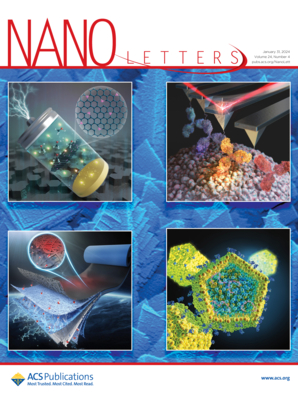IF 9.6
1区 材料科学
Q1 CHEMISTRY, MULTIDISCIPLINARY
引用次数: 0
摘要
非共价相互作用(NCIs)是生物键形成事件的关键,在化学的各个领域都有重要应用。在这里,我们首次展示了利用基于半导体的表面增强拉曼散射(SERS)光谱鉴定两种相互作用物种之间的多重非共价相互作用。这是通过设计具有米氏共振和电荷转移共振协同效应的亚微米级二氧化钛超结构来增强 SERS,从而使二氧化钛/4-巯基苯甲酸(MBA)体系同时具有高 SERS 活性和界面电荷转移灵敏度。研究结果清楚地表明,MBA 的振动频率与分子间从氢键到离子相互作用的各种相互作用相关。我们针对四种 DNA 碱基和单链 DNA 序列对 NCIs 进行了多次 SERS 分析。此外,我们还进行了一项概念验证研究,利用相对 SERS 强度检测单链 DNA 序列中两种碱基的相对含量。这项研究揭示了半导体 SERS 在探索分子间特异性相互作用方面的潜在应用。本文章由计算机程序翻译,如有差异,请以英文原文为准。

Semiconductor Superstructures with Multiple Synergistic Resonances for SERS Exploring Multiplex Noncovalent Interactions
Noncovalent interactions (NCIs) are crucial for biological bond-forming events and have significant applications across various branches of chemistry. Here, we demonstrate for the first time the identification of multiple NCIs between two interacting species using semiconductor-based surface-enhanced Raman scattering (SERS) spectroscopy. This was accomplished by designing submicrometer-sized TiO2 superstructures with synergistic effects of Mie and charge-transfer resonances for SERS enhancement, enabling the TiO2/4-mercaptobenzoic acid (MBA) system to achieve both high SERS activity and interfacial charge-transfer sensitivity. The results clearly indicate that the vibrational frequencies of MBA shift in correlation with various intermolecular interactions from hydrogen-bonding to ionic interactions. Multiple SERS analyses of NCIs were conducted for both the four DNA bases and single-stranded DNA sequences. Additionally, we performed a proof-of-concept study utilizing the relative SERS intensity to detect the relative content of two bases in single-stranded DNA sequences. This study unlocks potential applications of semiconductor SERS for exploring intermolecular-specific interactions.
求助全文
通过发布文献求助,成功后即可免费获取论文全文。
去求助
来源期刊

Nano Letters
工程技术-材料科学:综合
CiteScore
16.80
自引率
2.80%
发文量
1182
审稿时长
1.4 months
期刊介绍:
Nano Letters serves as a dynamic platform for promptly disseminating original results in fundamental, applied, and emerging research across all facets of nanoscience and nanotechnology. A pivotal criterion for inclusion within Nano Letters is the convergence of at least two different areas or disciplines, ensuring a rich interdisciplinary scope. The journal is dedicated to fostering exploration in diverse areas, including:
- Experimental and theoretical findings on physical, chemical, and biological phenomena at the nanoscale
- Synthesis, characterization, and processing of organic, inorganic, polymer, and hybrid nanomaterials through physical, chemical, and biological methodologies
- Modeling and simulation of synthetic, assembly, and interaction processes
- Realization of integrated nanostructures and nano-engineered devices exhibiting advanced performance
- Applications of nanoscale materials in living and environmental systems
Nano Letters is committed to advancing and showcasing groundbreaking research that intersects various domains, fostering innovation and collaboration in the ever-evolving field of nanoscience and nanotechnology.
 求助内容:
求助内容: 应助结果提醒方式:
应助结果提醒方式:


